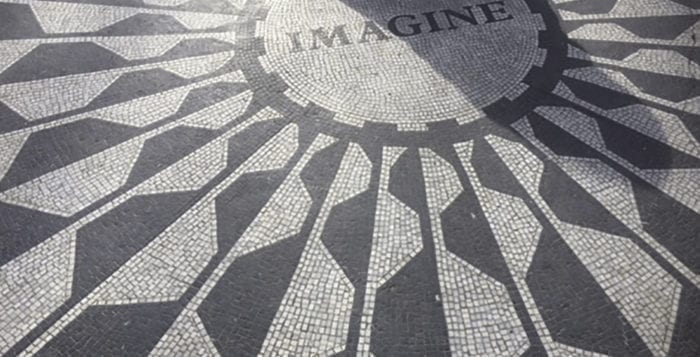Reviewed by Jeffrey Sanzel
Michael Di Leo’s debut novella is a powerful and engaging look at the days leading up to and just following the murder of John Lennon. Focusing on the separate and yet not completely disparate stories of several unrelated people, it creates a vivid chronicle of a time of great sadness and unrest.

It is December 1980 and the country is in the advent days before Ronald Reagan is to take office. Three very different people are facing the frustrations of day-to-day life. The story follows this trio as they attempt to tackle a series of emotionally difficult challenges.
Sixteen-year-old Angela is obsessed with the Beatles. She is struggling with the things that are modern and yearns for the ’60s, a time she never experienced but has come to venerate, epitomized by the music of the Beatles. Her friends do not understand her — in particular an insensitive but realistically portrayed boyfriend who has only one desire in their dysfunctional relationship. Angela is reaching back to a past era to try to make sense of her own.
Thirteen-year-old John is inspired to look at the ’60s by former hippie Mr. Watkins, his easygoing and inspiring teacher, who assigns John an extra-credit project to research the period.John is caught between his hard-edged, conservative father and a mother whose heart is connected to the freer time that she never allowed herself to fully experience.
Finally, Tommy, in his 20s, going nowhere, lives in a cramped Manhattan apartment, working a dead-end job selling typewriters, and trying to parse his exact feelings for his girlfriend, Mary, who is pressuring him for both a ring and a change in who he is. Like Angela, he is fixated on the Beatles. Tommy is also haunted by the death of his brother in Vietnam, a milestone that caused the implosion of his family and created his own sense of detachment from the world.
Tommy makes a point of his dis-ease in the universe. He feels that the ’80s have not yet started because there has been no defining moment to herald an age. He sites the assassination of JFK and the landing of the Beatles for the ’60s and Nixon’s resignation for the ’70s. He does not realize that his worst nightmare will be the signal of this new epoch.
Short, crisp chapters create small fragments that are windows into each of the character’s lives and thoughts. As it progresses, the picture, like a mosaic, becomes clearer.
The first half of this delicate, slender novella follows their day-to-day existences that are then shattered by John Lennon’s tragic murder. The latter part of the book then tracks the repercussions of this terrible event. Both Tommy and Angela are broken by Lennon’s death as is John’s mother. But it is through this loss that they find themselves and, in the grand scheme, are stronger for it.
It is the teacher, Mr. Watkins, who is able to best express this new time: “There were a lot of people in the sixties who influenced my generation. JFK, his brother Robert, Martin Luther King. And yet, John Lennon may have had more of an influence than any of them. And he survived it all and was in a position to possibly influence us again to make things better. Something he always tried to do. And they killed him, too. They’re all gone now.” It is the indicator of both an end and a beginning.

Tommy had lived in hope of a Beatles reunion. For him, “It wasn’t supposed to end this way.” The Sgt. Pepper album had gotten him through the loss of his brother, giving him solace in the worst of times. It is now, through the music and the memory, that he survives this next challenge. A particularly poignant description follows Tommy’s visit to his childhood home. He sees his parents, who have never recovered from the death of their oldest son, in a new light. The scene resonates on many levels. It is in this trip that Tommy realizes that he can make something of himself, and it is John Lennon’s example that inspires him to do so.
John’s mother opens up to her son with pieces of her life and heart that she had kept tamped down to please her husband and his expectations. Lennon’s death releases her true spirit. “You know, I always had a secret thing for the Beatles, and John, he was always my favorite. He was so smart and funny, and he always did or said what he wanted, whatever the consequences, and now after everything, he was back, and he was happy, and now he’s gone. It just doesn’t make any sense. I guess maybe I really was a hippie at heart.” She, like Tommy, eventually finds release in embracing her true feelings.
Di Leo’s compassion for his characters gracefully shows the initial shock turning to profound mourning and, ultimately, to redemption. It is a visceral portrayal. He manages, with great sensitivity, to give us a glimpse into the turmoil of these people’s souls. In addition, Di Leo is not seeking easy answers. Instead, he presents the phenomenon of our attachment to these icons. He sheds light on our personal connection to distant stars (literally and figuratively) and how we take their deaths in a personal way. It is a strange truth but we often suffer these losses deeper than we do of those who are truly close to us. He reveals this fact without judgment but instead with nonjudgmental insight.
A prescient touching upon the discussion of gun control that occurred in the wake of the shooting reminds us that though time has passed, many things have not changed.
A gathering in Central Park of thousands of fans serves as a gentle climax to the book where the characters intersect but don’t truly interact. Di Leo chooses not to give us facile coincidence but instead reflects life as it is. A beautiful and honest coda provides both closure and hope — that out of even the darkest times can come good, and, in this case, light.
Much like the “Imagine” mosaic created in memory of Lennon, “Images of Broken Light” gives us broken figures that create a powerful and memorable whole.
“Images of Broken Light” is available in paperback and Kindle versions on Amazon.com, and E-books are also available on Barnesandnoble.com, iBooks and Kobo. This is the Nesconset resident’s second book. The first, titled “The Spy Who Thrilled Us,” covers the first 19 films in the James Bond series. For more information, visit his website at www.michaeldileoauthor.com.





